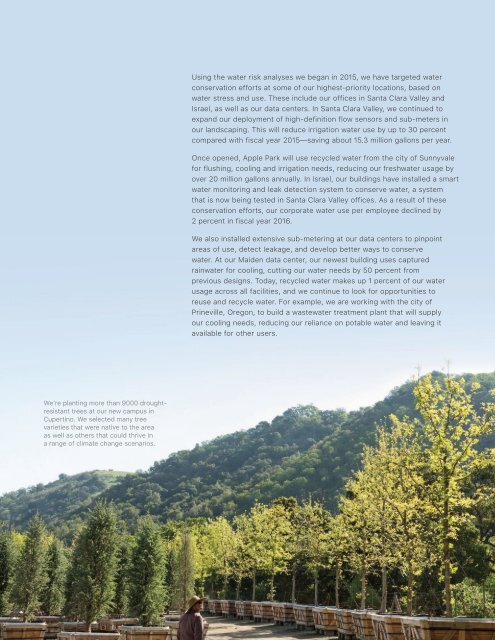Apple Environmental Responsibility Report
You also want an ePaper? Increase the reach of your titles
YUMPU automatically turns print PDFs into web optimized ePapers that Google loves.
Using the water risk analyses we began in 2015, we have targeted water<br />
conservation efforts at some of our highest-priority locations, based on<br />
water stress and use. These include our offices in Santa Clara Valley and<br />
Israel, as well as our data centers. In Santa Clara Valley, we continued to<br />
expand our deployment of high-definition flow sensors and sub-meters in<br />
our landscaping. This will reduce irrigation water use by up to 30 percent<br />
compared with fiscal year 2015—saving about 15.3 million gallons per year.<br />
Once opened, <strong>Apple</strong> Park will use recycled water from the city of Sunnyvale<br />
for flushing, cooling and irrigation needs, reducing our freshwater usage by<br />
over 20 million gallons annually. In Israel, our buildings have installed a smart<br />
water monitoring and leak detection system to conserve water, a system<br />
that is now being tested in Santa Clara Valley offices. As a result of these<br />
conservation efforts, our corporate water use per employee declined by<br />
2 percent in fiscal year 2016.<br />
We also installed extensive sub-metering at our data centers to pinpoint<br />
areas of use, detect leakage, and develop better ways to conserve<br />
water. At our Maiden data center, our newest building uses captured<br />
rainwater for cooling, cutting our water needs by 50 percent from<br />
previous designs. Today, recycled water makes up 1 percent of our water<br />
usage across all facilities, and we continue to look for opportunities to<br />
reuse and recycle water. For example, we are working with the city of<br />
Prineville, Oregon, to build a wastewater treatment plant that will supply<br />
our cooling needs, reducing our reliance on potable water and leaving it<br />
available for other users.<br />
We’re planting more than 9000 droughtresistant<br />
trees at our new campus in<br />
Cupertino. We selected many tree<br />
varieties that were native to the area<br />
as well as others that could thrive in<br />
a range of climate change scenarios.<br />
<strong>Environmental</strong> <strong>Responsibility</strong> <strong>Report</strong> | 2017 Progress <strong>Report</strong>, Covering FY2016<br />
21







